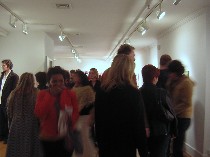 Spring finally came to First Friday; it was mobbed, with galleries looking a lot like clubs on a Saturday night, people trying to slip by eachother without touching–an impossibility given the circumstances . At the Clay Studio, the crowd was so thick that the in and out came to a halt in the Isaiah Zagar-decorated hallway. Traffic jam. (left, upstairs at Temple Gallery).
Spring finally came to First Friday; it was mobbed, with galleries looking a lot like clubs on a Saturday night, people trying to slip by eachother without touching–an impossibility given the circumstances . At the Clay Studio, the crowd was so thick that the in and out came to a halt in the Isaiah Zagar-decorated hallway. Traffic jam. (left, upstairs at Temple Gallery).ritchie, matthew
Artist entrepreneurs on the streets hawked their wares, and my daughter even made a purchase–a gift for my son’s new office on the occasion of his birthday.
Roberta and I started out when we bumped into each other at the Matthew Ritchie opening at the Fabric Workshop and Museum. The show is called “Proposition Player,” a term for a professional gambler who the house expects to encourage others to lay their money down.
I’ve never been really interested in Ritchie’s work–a little too abstruse and unexplained for me, with fantastic systems colliding with the mysteries of the universe and not quite enough visual thrills to compensate for the opacity.
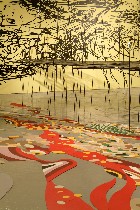 But this time, I was sold. I admired the ambition to conquer the formidable space of the entire sixth floor of the Fabric Workshop, the limitless interest in systems for making images as well as systems of thought, systems of science and systems of chance. I admired the way things looked–juicy, bold sweeps of gesture (right, an installation shot at the Fabric Workshop).
But this time, I was sold. I admired the ambition to conquer the formidable space of the entire sixth floor of the Fabric Workshop, the limitless interest in systems for making images as well as systems of thought, systems of science and systems of chance. I admired the way things looked–juicy, bold sweeps of gesture (right, an installation shot at the Fabric Workshop).
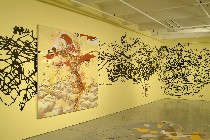 Here, Ritchie casts himself as the creator, and his universe lies somewhere not too far west of Dungeons & Dragons territory and not quite as close as he might like to the star-borning nebulae that took our breaths away when we saw the images from NASA. But you can’t blame a guy for trying. And in fact he does successfully call up visions of dragons and life forces on the move across an unknown and unknowable landscape (left, “The Hierarchy Problem” painted on wall, and “A Glorious Martyrdom Awaits Us All at the Hands of Our Tender and Merciful God,” hanging on the wall) .
Here, Ritchie casts himself as the creator, and his universe lies somewhere not too far west of Dungeons & Dragons territory and not quite as close as he might like to the star-borning nebulae that took our breaths away when we saw the images from NASA. But you can’t blame a guy for trying. And in fact he does successfully call up visions of dragons and life forces on the move across an unknown and unknowable landscape (left, “The Hierarchy Problem” painted on wall, and “A Glorious Martyrdom Awaits Us All at the Hands of Our Tender and Merciful God,” hanging on the wall) .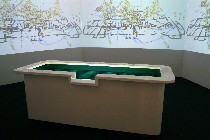 The names of the pieces in the exhibit range from high hubris to mysterious say-whatism. They include “The God Impersonator,” a swoopy floor mat of interlocking colors and shapes; “Proposition Player,” an interactive craps table where the dice set off a series of images projected on the table top and on the walls (image, right); and “The Two-Way Joint,” a backlit lenticular print (that’s a fancy way of saying it’s a giant version of those Cracker Jack prizes that shift from one image to another as you adjust its position). There’s lots of other stuff as well.
The names of the pieces in the exhibit range from high hubris to mysterious say-whatism. They include “The God Impersonator,” a swoopy floor mat of interlocking colors and shapes; “Proposition Player,” an interactive craps table where the dice set off a series of images projected on the table top and on the walls (image, right); and “The Two-Way Joint,” a backlit lenticular print (that’s a fancy way of saying it’s a giant version of those Cracker Jack prizes that shift from one image to another as you adjust its position). There’s lots of other stuff as well.
But the names are a false division, because Ritchie explained (he was there) that the pieces are pieces of a larger whole, an ongoing work of expansion and gesture without limit.
And, honestly, that is sort of how the whole thing reads.
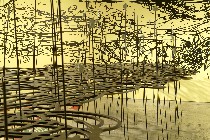 The wall drawing “The Heirarchy Problem” that swooped around the largest gallery, with “The God Impersonator” on the floor and a marvelous, waist-high, parallel-to-the-floor black aluminum network propped up with lots of slender stakes, some topped with head-like blobs, “The Fine Constant,” delivered a medieval landscape of challenges and dangers, a sort of playful take on Pilgrim’s Progress (left, “The Fine Constant” in the foreground, “The Hierarchy Problem” on the wall behind). Two huge paintings in the same space, “The Living Will” and “A Glorious Martyrdom Awaits Us All at the Hands of Our Tender and Merciful God,” suggest the grand size and complexity of the universe as well as poor Pilgrim’s place in it all.
The wall drawing “The Heirarchy Problem” that swooped around the largest gallery, with “The God Impersonator” on the floor and a marvelous, waist-high, parallel-to-the-floor black aluminum network propped up with lots of slender stakes, some topped with head-like blobs, “The Fine Constant,” delivered a medieval landscape of challenges and dangers, a sort of playful take on Pilgrim’s Progress (left, “The Fine Constant” in the foreground, “The Hierarchy Problem” on the wall behind). Two huge paintings in the same space, “The Living Will” and “A Glorious Martyrdom Awaits Us All at the Hands of Our Tender and Merciful God,” suggest the grand size and complexity of the universe as well as poor Pilgrim’s place in it all.
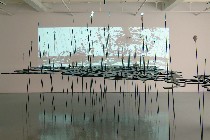 Another installment of “The Fine Constant” stood before a mesmerizing projected animation of tumbling black atom-like spheres, “Clinamen” (image, right).
Another installment of “The Fine Constant” stood before a mesmerizing projected animation of tumbling black atom-like spheres, “Clinamen” (image, right).
I suppose I thought the craps table was a little pretentious, not quite delivering the shiver that chance’s interplay with the rules of the universe ought to, but I did have fun there, and stood playing for a bit with the giant plastic casts of ankle-bone dice. I also was happy to take home my playing card, which was my admission ticket to play at the table. The card is part of a 49-card set (magic seven by seven in the display on the wall) with swell little Ritchie-created characters on each. These too seemed a little precious.
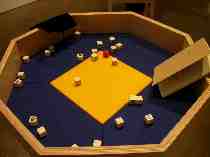 Ritchie, who was born in London, still has traces of his British accent, but he now lives and works in New York City. The games reminded me of Alan McCollum and Matt Mullican, whose “Your Fate” inspired Roberta to purchase a set of their dice a while ago (see her post). Ritchie’s cards also reminded me even more of Annabel Daou’s cards coincidentally showing at Gallery Joe, but Daou’s cards are about how the rules can change on you.
Ritchie, who was born in London, still has traces of his British accent, but he now lives and works in New York City. The games reminded me of Alan McCollum and Matt Mullican, whose “Your Fate” inspired Roberta to purchase a set of their dice a while ago (see her post). Ritchie’s cards also reminded me even more of Annabel Daou’s cards coincidentally showing at Gallery Joe, but Daou’s cards are about how the rules can change on you.mccollum, alan
We finally tore ourselves away from the Fab and moved on to Vox Populi and Highwire galleries.
At Vox, Robert Chaney’s polaroid photos immediately struck a chord, and Kara Crombie’s video at a glance looked like it was worth a return visit (we wrote about her high-on-soda piece in “Junto” here). Also showing were Matthew Suib’s movie revisions and Keith Breitfeller’s paintings, as well as a continuation of Jonathan Berger’s “Goner” (see Roberta’s post here). I picked up Berger’s newsprint poster and left happy.
At Highwire, as if trying to make up for the male-dominated, contemporary art showing at Greater New York 2005 at P.S. 1, there are two shows by women only. Corpus VI has barely a note of the contemporary in it. The work, mostly traditional figure drawings and paintings, included some startling, confrontational nudes done with amazing technique by Clarity Haynes. The others in the exhibit were Rachel Constantine, Georganna Lenssen, Suzanne Schireson, Elena Peteva and Willow Bader. Also showing there is a group show, “Here and Now,” from the local Women’s Caucus for Art.
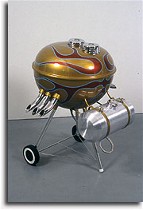
From there we stopped in at Gallery Joe (see post)
and then Carbon 14 (126 N. Third St. 215.923.2352) for Brian McCutcheon and his hot-rod barbecue sculpture and big backyard grass photo (image right, “Trailer Queen”).
 And then Roberta headed home, while I headed into Silicon for Richard Ryan’s fractured portraits and streetscapes, visual puzzles that eventually begin to resolve and clarify (left, “19th and Spruce 4”). I also dropped in at Nexus for Susan Abrams’ portraits on silk and Virginia Batson’s word sculpture (my daughter also stopped there and said she loved the words, loved the interactivity of pulling aside the little leather covers, and thought they were hilarious; I think there was an age gap here, because I did see lots of young folks lifting up the little swatches and reading one message after the other).
And then Roberta headed home, while I headed into Silicon for Richard Ryan’s fractured portraits and streetscapes, visual puzzles that eventually begin to resolve and clarify (left, “19th and Spruce 4”). I also dropped in at Nexus for Susan Abrams’ portraits on silk and Virginia Batson’s word sculpture (my daughter also stopped there and said she loved the words, loved the interactivity of pulling aside the little leather covers, and thought they were hilarious; I think there was an age gap here, because I did see lots of young folks lifting up the little swatches and reading one message after the other).
atzberger, liz
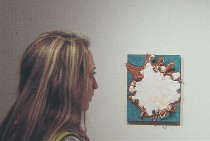 My last stop was Temple Gallery for the Tyler MFA shows, which are too short-lived. The place was mobbed. Downstairs were Ana Hernandez’s sexy red velvet sculptures and upstairs, Liz Atzberger’s plastic fantastic rubberband and stretch-fabric constructions had the mobs slowing down and really looking (right, one of Atzberger’s pieces). This show went up March 30 and lasted through yesterday. Stop in the gallery for the list of who’s showing when and where.
My last stop was Temple Gallery for the Tyler MFA shows, which are too short-lived. The place was mobbed. Downstairs were Ana Hernandez’s sexy red velvet sculptures and upstairs, Liz Atzberger’s plastic fantastic rubberband and stretch-fabric constructions had the mobs slowing down and really looking (right, one of Atzberger’s pieces). This show went up March 30 and lasted through yesterday. Stop in the gallery for the list of who’s showing when and where.









